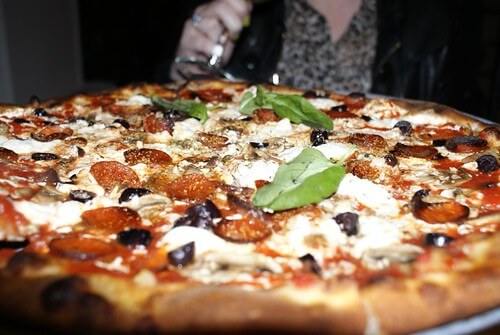
There are far too many advantages to making your own pizza at home. For one, you can’t beat the sweet taste of making something with your bare hands, and for another, homemade pizza is a lot of fun. However, things can go wrong quickly, especially if you’re unfamiliar with the proportions, dough, and cooking time. Our crew at Pequod’s Pizza wants to share with you some of the most common mistakes made when making DIY pizza at home. Hopefully, after reading this, you’ll be a pizza pro.
Wrong Yeast Usage

Pizza by Nicholas Cole is licensed with CC BY 2.0
Many people think the more yeast they add, the more dough will rise, but that couldn’t be further from the truth. If you’ve ever read a pizza recipe, you know that the recommended amount is only ½ teaspoon. This is because a small amount of yeast is essential for slow fermentation. The slower the fermentation process, the more flavorful the dough.
So please, stick to this amount of yeast and let it do its thing. You’ll thank us when your dough tastes heavenly. And don’t forget to mix it in warm (not boiling) water with a teaspoon of sugar or honey and let it sit for 15-30 minutes.
Adding Ingredients at the Wrong Time
Did you know that the order in which you add ingredients is essential? If you do it wrong, you’ll mess up the dough and change how it turns out. Although this is a beginner’s mistake, it’s very common because many people tend to think that there’s no specific order for making pizza dough. Needless to say, there is. Always start with the yeast and give it time to activate. Then mix it with flour, add water slowly, and finish with salt.
Alternatively, you can mix instant yeast with flour without activating it first. That’s about the only change you can make, or your dough may not turn out the way you want. For example, adding salt at the same time as the yeast is a recipe for disaster because the salt inhibits the yeast, which means the dough won’t rise.
Not Letting the Dough Be
You want to think of your dough as an introvert who likes a little attention from time to time but nothing too crazy. In other words, don’t make things more complicated than they need to be. For example, kneading is concise, so don’t overdo it by spending more time than recommended. You also need to give it time to rest; the gluten in your dough needs to relax so it can absorb water.
Also, letting your dough rest for 30 minutes to an hour is the key to a fluffy, soft, and light dough. The last thing you want is for your dough to be sticky and heavy.
Thinning the Dough Too Much
We know the world is divided into thin-crust and deep-dish people, and while we here at Pequod’s are the latter, we don’t judge those who like their pizza as thin as a cracker. However, many people seem to think that rolling the dough as thin as possible is the way to make a thin crust. But that only weakens the dough, which means it won’t support the sauce or toppings.
For a thin-crust pizza, be careful when rolling out the dough, and make it at least an inch thick. Don’t worry; it’ll turn out thin.
Using Regular Flour To Stretch the Dough
For many, making the dough is no problem. They know how to do the mixing and kneading, but when it comes to the stretching part, where there should be a circular pizza, a weirdly shaped one lies instead. Most of the time, this is because people use regular flour to stretch the dough when they should be using semolina flour instead.
Adding regular flour after the dough has risen causes it to lose its elasticity and changes the texture as it absorbs the added flour. As you can see, creating the ideal base for your pizza masterpiece is crucial.
Using Too Much Cheese
We want everyone on Earth to know that adding more cheese than recommended won’t make your pizza any tastier — seriously. Please avoid it; too much cheese can make the crust soggy from the fat. It can also cause the dough to fall apart because of the weight. Stick to the recommended amount.
Using Too Many Toppings
Just like too much cheese, adding too many toppings is an easy way to ruin a pizza. First, if you’re craving different toppings, making different pizzas is better. Second, the dough can tear. And third, adding too many toppings to a pizza can lead to undercooked ingredients and a burnt crust.
Not Heating the Oven Enough
When making pizza, preheat the oven to its maximum temperature. Don’t wait until the pizza is ready to turn it on. Otherwise, the dough won’t rise because the yeast in the dough needs a high temperature to start working. As a rule of thumb, preheat the oven to its highest temperature for 45 to 50 minutes before placing the pizza in the oven.
Not Letting the Pizza Cool
We get it, pizzas are delicious and really hard to resist, but we’re just asking you to let them cool for a bit. Don’t worry; all we’re asking is that you let them cool for three to four minutes after they come out of the oven. This gives the cheese time to set and enhances the pizza’s overall flavor. And as a bonus, you won’t burn the roof of your mouth, so it’s a win-win.
At Pequod’s, we not only serve Chicago’s best deep-dish pizza, but we also like to educate our customers, so we can all enjoy this delicious dish as it should be. Whether you’re team pan or team thin crust, we serve both styles with a wide variety of toppings, including anchovies, pepperoni, green olives, Italian beef, mushrooms, Canadian bacon, sausage, onions, and our staple cheese. Come try us, and let us show you the right way to eat pizza.